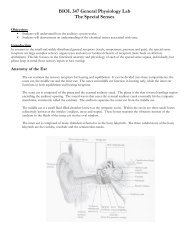Gustation & Olfaction - Stark home page
Gustation & Olfaction - Stark home page
Gustation & Olfaction - Stark home page
You also want an ePaper? Increase the reach of your titles
YUMPU automatically turns print PDFs into web optimized ePapers that Google loves.
<strong>Gustation</strong> & <strong>Olfaction</strong><br />
Traditional and modern
Tongue<br />
• Hanig (1901) - preferential localization:<br />
• sweet - tip of tongue<br />
• salt - front sides of tongue<br />
• sour - back sides of tongue<br />
• bitter - back middle of tongue<br />
• Correlation is not exclusive is not really<br />
true.
Papillae:<br />
Circumvallate back of tongue<br />
• foliate sides of tongue<br />
• fungiform front of tongue<br />
• also receptors in epiglottis
• Papillae > taste buds<br />
• support cells,<br />
• sensory cells,<br />
• and basal cells<br />
Histology<br />
• As with olfaction, a unique feature is the<br />
turnover of receptor cells
Recent papers<br />
• genetic taste "blindnesses"<br />
• Ptc= phenylthiocarbamide, taster is dominant.<br />
• Use taste vs. non-taste to screen for G-protein<br />
coupled receptors<br />
• “ Family of bitter taste receptors found,” 2000<br />
• Drayna, “Founder mutations.” 2005, 78-85.<br />
• "...seven different forms of the PTC gene exist in<br />
sub-Saharan Africa. But only the major taster and<br />
nontaster forms have been found...outside of<br />
African populations.
Papers (continued)<br />
• "taster detects chemicals with C=N-S<br />
• (1) taster and nontaster are ancient<br />
• (2) tasters and nontasters populated the<br />
world ("Out of Africa" hypothesis)<br />
• (3) these people did not interbreed with<br />
others (like Neanderthals).<br />
• only taster in all other primates
Papers (continued)<br />
• Kim ...Drayna, …cloning PTC, 2003<br />
• human chromosome 7q, there are nine<br />
TRA2R (bitter taste genes) and 7 olfactory<br />
receptor genes in this area.<br />
• PTC is 1002 bp and 1 exon<br />
• 3 single nucleotide polymorphisms (SNPs)<br />
explain PTC taste insensitivity, A49P,<br />
V262A, I296V
Charles Zuker<br />
• isolation of taste receptors T1R1, T1R2, T1R3,<br />
T2R,<br />
• also the involvement of the TRP channel. Earlier,<br />
Drosophila phototransduction.<br />
• HHMI = Howard Hughes Medical Institute which<br />
has helped to fund innovative and productive<br />
scientists like Charles.<br />
• There are easy to read HHMI press releases here.
Tuning<br />
• (how selective is receptor?)<br />
• work by Carl Pfaffman, 1941, & since -<br />
• receptors are not all that specific<br />
• Contradicted by very modern data supporting<br />
"labeled line hypothesis" (in book).<br />
• This applies to G protein coupled receptors, T2R1<br />
plus T1R3 for sweet, T1R1 plus T1R3 for umami,<br />
and T2R for bitter
Projection<br />
• (much simpler than for olfaction)<br />
• epiglottis via nerve X (vagus),<br />
• circumvallate (9 of them) IX glossopharyngial<br />
• others via VII (facial)<br />
• Gustatory (solitary) nucleus in medulla,<br />
• there to thalamus and then to sensory cortex<br />
• (overlap to touch area - postcentral gyrus)<br />
• also from solitary to hypothalamus
Trigeminal chemoreception<br />
• Capsaicin (covered in the chapter on pain,<br />
Chapter 10)<br />
• for polymodal nociceptive fibers<br />
• Trigeminal (5)<br />
• mediates irritants
Smell- <strong>Olfaction</strong><br />
• chemicals (air)<br />
• Landmark paper:Karlson Pheromones<br />
1959<br />
• sex attractants like a 10 carbon acetate.<br />
• It can attract male from a few miles who<br />
flies upwind at first.<br />
• Pheromones have been used to trap pests.
complications<br />
• unusual primaries like “aromatic and putrid”<br />
• many primaries, although mixtures give a single<br />
perception confounding the ability to define<br />
primaries<br />
• Relative to other senses, receptors difficult to<br />
stimulate<br />
• Perhaps more than with the sense of touch,<br />
olfaction is related to motivational "affect"<br />
• The sense of smell is especially important in other<br />
animals (dogs)
Properties<br />
• olfactory epithelium.<br />
• receptors are neurons<br />
• Receptors turn over (this is unusual),<br />
• (dividing stem cell and developing (immature)<br />
receptor),<br />
• since cells are very exposed (to dry air, pathogens,<br />
etc.).<br />
• New cells must establish connections.<br />
• There are also sustaining cells
Properties<br />
• Receptors are ciliary with "9 + 2"<br />
arrangement of microtubules as seen<br />
structurally.<br />
• Cilia are in mucus<br />
• slowly adapting (receptors) even though it<br />
seems otherwise (processing)
Transduction<br />
• G protein coupled receptor<br />
• adenylate cyclase<br />
• olfactory alpha subunit of the G protein (Golf)<br />
• Na+- Ca2+ channel like that of photoreceptor:<br />
• cAMP ligand to open the channel from inside<br />
• Ca2+ opens Cl- channel<br />
• PLC and IP3<br />
• there is a Na+/Ca++ exchanger
Recent work<br />
• Barnes,…Axel, relates to Axel & Buck 2004<br />
Nobel<br />
• Odorant Receptors on axon termini in the brain,<br />
2004<br />
• Each cell expresses only one type of receptor.<br />
• Seemingly randomly arranged on olfactory<br />
epithelium.<br />
• axons with same receptors converge at glomeruli.<br />
• same receptors are used in axon guidance.
Recent work<br />
• Postnatal refinement of peripheral olfactory<br />
projections, 2004.<br />
• "A hallmark of mature glomeruli is that they are<br />
innervated exclusively by axons from olfactory<br />
sensory neurons expressing the same olfactory<br />
receptor."<br />
• (1) Glomeruli start out heterogeneous<br />
• heterogeneous glomeruli decreases with<br />
development.<br />
• (2) Sensory stimulation contributes to the final<br />
unique mapping.
From notes<br />
• number and organizations of genes and<br />
proteins in C. elegans, Drosophila, mouse,<br />
human<br />
• no introns in mammals<br />
• distribution of genes in human, many on 11
Projection<br />
• Glomeruli - > Mitral cells -> lateral<br />
olfactory tract (stria)<br />
• Also Periglomerular cells and Granule cells<br />
for processing<br />
• There is specificity of projection (space) of<br />
specific odorants to olfactory bulb favoring<br />
labeled line scheme of processing



